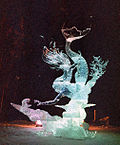Ice sculpture

An ice sculpture is a form of sculpture that uses ice as the raw material. Sculptures from ice can be abstract or realistic and can be functional or purely decorative. Ice sculptures are generally associated with special or extravagant events because of their limited durability. They can be found at weddings, banquets, and gala events, among others. The creation of ice sculptures is considered a form of artistic expression and requires both precision and creativity from the sculptor.
History[edit]
The history of ice sculpture dates back to prehistoric times when indigenous people of the Arctic regions carved tools and art from ice. However, the modern practice of ice sculpting began in China during the Heilongjiang International Ice and Snow Sculpture Festival, which started over 40 years ago. This festival showcases large ice sculptures and has contributed significantly to the popularity and development of ice sculpting as an art form.
Creation Process[edit]
The creation of an ice sculpture begins with the selection of a clear, clean block of ice. This ice can be natural, harvested from frozen lakes or rivers, or made artificially in a controlled environment to ensure clarity and purity. The sculptor then uses a variety of tools, including chainsaws, chisels, grinders, and specialized ice sculpting tools, to carve the ice block into the desired shape.
Types of Ice Sculptures[edit]
Ice sculptures can range from small, table-top pieces to large, immersive installations. Common types include:
- **Single block sculptures:** Carved from a single block of ice, these sculptures can be anything from simple designs to intricate, detailed works of art. - **Multi-block sculptures:** Larger and more complex, these sculptures are created by fusing multiple blocks of ice together. - **Ice bars and luges:** Functional sculptures that serve as actual bars for serving drinks or luges for chilling beverages. - **Live ice carving demonstrations:** These are performances where an ice sculptor creates a sculpture in front of an audience, often at events or festivals.
Preservation[edit]
Due to the transient nature of ice, sculptures are temporary and begin to melt as soon as they are carved. To prolong their life, sculptures are often displayed in cold environments or on top of ice trays. Lighting is also an important aspect of displaying ice sculptures, with colored lights often used to enhance their appearance.
Cultural Significance[edit]
Ice sculptures have a significant cultural presence in countries with cold climates, such as Canada, Russia, and Sweden, where ice festivals featuring ice sculpture competitions are common. These sculptures are not only a form of artistic expression but also a celebration of the winter season and cold weather.
Environmental Considerations[edit]
While ice sculptures are admired for their beauty and craftsmanship, there are environmental considerations regarding their creation and disposal. The use of electric tools and the need for artificial cooling for display and preservation can contribute to energy consumption. However, as the sculptures melt, they return to water, leaving no waste behind.
-
Ice sculpture in Quebec city downtown
-
Ice sculpture
-
Ai Weiwei's Ice Sculptures in Stockholm 2014
-
Ice sculpture
-
Ice sculpture
-
Ice Castle - Lake Louise Jan 2005
-
Harbin Ice Festival
-
Ice sculpture
-
Ice sculpture
-
Ice sculpture
-
Ice sculpture
Ad. Transform your life with W8MD's Budget GLP-1 injections from $75


W8MD offers a medical weight loss program to lose weight in Philadelphia. Our physician-supervised medical weight loss provides:
- Weight loss injections in NYC (generic and brand names):
- Zepbound / Mounjaro, Wegovy / Ozempic, Saxenda
- Most insurances accepted or discounted self-pay rates. We will obtain insurance prior authorizations if needed.
- Generic GLP1 weight loss injections from $75 for the starting dose.
- Also offer prescription weight loss medications including Phentermine, Qsymia, Diethylpropion, Contrave etc.
NYC weight loss doctor appointmentsNYC weight loss doctor appointments
Start your NYC weight loss journey today at our NYC medical weight loss and Philadelphia medical weight loss clinics.
- Call 718-946-5500 to lose weight in NYC or for medical weight loss in Philadelphia 215-676-2334.
- Tags:NYC medical weight loss, Philadelphia lose weight Zepbound NYC, Budget GLP1 weight loss injections, Wegovy Philadelphia, Wegovy NYC, Philadelphia medical weight loss, Brookly weight loss and Wegovy NYC
|
WikiMD's Wellness Encyclopedia |
| Let Food Be Thy Medicine Medicine Thy Food - Hippocrates |
Medical Disclaimer: WikiMD is not a substitute for professional medical advice. The information on WikiMD is provided as an information resource only, may be incorrect, outdated or misleading, and is not to be used or relied on for any diagnostic or treatment purposes. Please consult your health care provider before making any healthcare decisions or for guidance about a specific medical condition. WikiMD expressly disclaims responsibility, and shall have no liability, for any damages, loss, injury, or liability whatsoever suffered as a result of your reliance on the information contained in this site. By visiting this site you agree to the foregoing terms and conditions, which may from time to time be changed or supplemented by WikiMD. If you do not agree to the foregoing terms and conditions, you should not enter or use this site. See full disclaimer.
Credits:Most images are courtesy of Wikimedia commons, and templates, categories Wikipedia, licensed under CC BY SA or similar.
Translate this page: - East Asian
中文,
日本,
한국어,
South Asian
हिन्दी,
தமிழ்,
తెలుగు,
Urdu,
ಕನ್ನಡ,
Southeast Asian
Indonesian,
Vietnamese,
Thai,
မြန်မာဘာသာ,
বাংলা
European
español,
Deutsch,
français,
Greek,
português do Brasil,
polski,
română,
русский,
Nederlands,
norsk,
svenska,
suomi,
Italian
Middle Eastern & African
عربى,
Turkish,
Persian,
Hebrew,
Afrikaans,
isiZulu,
Kiswahili,
Other
Bulgarian,
Hungarian,
Czech,
Swedish,
മലയാളം,
मराठी,
ਪੰਜਾਬੀ,
ગુજરાતી,
Portuguese,
Ukrainian











